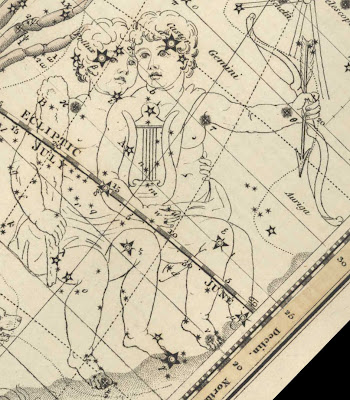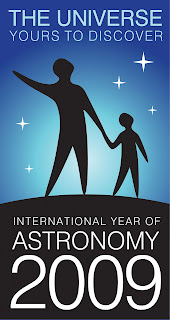First, the two stars are of similar apparent magnitude, that is, how bright a star appears to us on Earth. Second, they are close together in the sky, approximately four finger-widths apart, if you hold your hand at arm’s length against the sky, and measure across the knuckles. Third, there are no other bright stars right near them, so they stand out. Procyon (PRO-see-ahn), the nearest star that’s brighter than the twin stars, is about two fist-widths away, in the constellation Canis Minor the Little Dog.

Gemini the Twins in Alexander Jamieson’s 1822 star atlas
Courtesy of Linda Hall Library of Science, Engineering and Technology
For the ancient seafaring peoples of the Mediterranean region, the appearance of Gemini in the sky signaled the approach of fairer weather. The Twins were considered to be the friends and protectors of navigation, and they were known as the Sailor’s Stars. When I see them high in the sky after sunset, I know that spring is on its way.
Let’s set a course for the bright lights of Gemini.
1) About an hour after sunset, face south. If you don’t know the cardinal directions at your location and you don’t have a compass, make note of where the sun sets on the horizon. That spot is approximately west. Stand with your right shoulder to the west, and you’ll be facing approximately south.
 Star map created with Your Sky
Star map created with Your Sky
2) First locate the Hourglass asterism (star pattern) of Orion the Hunter, just east of the meridian. Above it, to the north, find the Pentagon asterism of Auriga. Midway between the Hourglass and the Pentagon, but over to the east, are the Gemini Twins. Pollux is on the left (farthest south), and Castor is on the right (farthest north).
3) Pollux (PAH-lucks) is the brighter of the two. An orange giant star ten times the diameter of our Sun, Pollux is of particular importance because of the planet discovered in orbit around it.
4) Castor (KASS-turr), in contrast to colorful Pollux, is a white star. But bland it is not. Look at Castor through a telescope, and you’ll see that it is actually two stars. The two stars, Castor A and Castor B, are in orbit around each other. Naked eye, we see their combined light as one star. But we’re not finished. There’s a Castor C too! You won’t see it, but Castor C is in orbit around the orbiting pair of A and B.
Wait, there’s more! Castor A, Castor B, and Castor C each have their own companion star. They are, in effect, each an orbiting pair of stars. That’s right, what looks like one star in Gemini is really six stars.
Forget the “Sailor’s Star.” I propose we call Castor the “Sextuplet Star.”

Astronomy Essential: Starlight takes years to reach your eyes.
The stars in the night sky lie far beyond the distant edges of our solar system. Even the one closest to Earth, Proxima Centauri (PROCK-simm-uh senn-TAH-ree), lies over four light years away.
Distances in outer space are vast, which is why we express them in terms of light years. A light year is the distance light travels in one Earth year, nearly six trillion miles. And as far as we know, nothing in the universe travels faster than light.
So, if you look at Proxima Centauri (you'll need to be in the Southern Hemisphere, and you’ll need a telescope), the light reaching your eyes left the star about four years ago. In other words, you are seeing the star as it existed four years ago. You might say that stargazing is a form of time travel.
The nearest naked-eye star visible to Northern Hemisphere observers (not counting the Sun) is Sirius, which is also the brightest star in the night sky, as seen from anywhere on Earth. Sirius is easily seen in the winter sky, southeast of Orion. When you look at Sirius, consider this: the light reaching your eyes left the star about eight and a half years ago. What were you doing, eight and a half years ago?